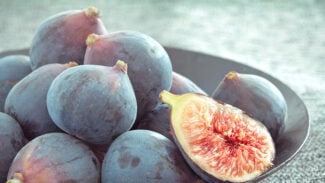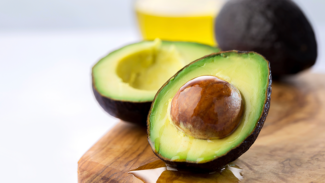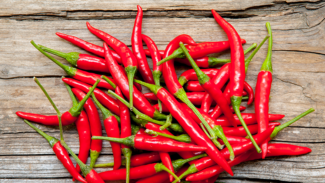Hiya Gorgeous,
Many of us dread doctor appointments, even when we love our doctors. This is especially true if we’ve been encouraged to change our diet and exercise regime, but didn’t make much progress. Hey, it happens. You blink and another year’s gone by. But, those annual check ups and tweaks to our self-care are pretty important, particularly if we’re dealing with one of the most common issues facing people today—high cholesterol.
You might be confused about cholesterol’s true impact on heart health because there’s been a lot of buzz about it recently, so I teamed up with Jen Reilly, our resident R.D., to bring you more of the facts on this somewhat hot topic.
Cholesterol used to be thought of as the one and only determinant of heart disease risk. However, researchers have now figured out that cholesterol is just one piece of the puzzle (with triglycerides, blood pressure, obesity and diabetes being some of the other pieces) (study).
A low-fat diet used to be what was recommended for lowering cholesterol and preventing heart disease. Diet recommendations have now changed and are focused on making sure you’re getting enough omega-3 fats, which can raise your good cholesterol, avoiding trans fats and limiting saturated fats, which can increase your bad cholesterol.
Some researchers and diet experts have begun to downplay the role of saturated fat when it comes to heart disease risk and cholesterol levels (research article). However, their conclusions are based on observational studies, which are not as reliable when it comes to showing definitive cause and effect. Saturated fats (and mostly the ones from animal sources) are still only a part of the heart disease equation, but should be limited if you want to keep your ticker and other parts of your body healthy.
New to the heart disease risk party is sugar. Research is now pointing to avoiding simple carbs and added sugars, especially added fructose, as it increases triglyceride levels and other risk factors for heart disease (study). The good news is, many of the heart health recommendations are still the same: lots of plant-based foods, fiber, keeping a healthy weight, exercising—and avoiding smoking, of course!
But, the fact remains that over 102 million adults in the US have high cholesterol. That’s a lot of folks! Although cholesterol isn’t the only indicator of heart disease—it still matters (study) because it can increase your risk for build-up in the walls of your arteries.
So, here are the three main warning signs your doctor is looking for when monitoring your cholesterol: 1. A low level of good cholesterol (HDL) in comparison to your total cholesterol level. 2. Bad cholesterol that contains lots of the riskier small, dense particles (there are three kinds of particles and the smallest is not good for your ticker). 3. High triglycerides (cholesterol’s cousins) (study, study, and study). This can lead to blockages and a heart attack or stroke—not something we wanna mess around with.
In addition to what we’ve discussed above, here are some additional ways you can adjust your food choices to prevent high cholesterol and heart disease.
4 Ways to Lower Cholesterol & Boost Heart Health With Food
Hopefully, your health practitioner has mentioned that food choices, exercise and weight control can have powerful effects on your cholesterol and triglycerides. If not, see if he/she will give you a 6-month chance to make changes and retest your levels before prescribing statins. It usually takes about 6 months for your body to react to diet changes, so be patient and persistent.
You’ve probably heard the typical recommendations when it comes to keeping your arteries clear. Eat more veggies. Stay away from too many saturated animal fats, trans fats, and fried foods. Limit sweets and simple carbs that will increase your triglycerides (and possibly increase the worst kind of bad cholesterol). Maintain a healthy weight, reduce stress and exercise. When it comes to the diet portion of your plan, there are some additional tweaks you can make to increase your artery-clearing power.
- Learn to love yellow. Turmeric root contains curcumin, which gives curry its bright yellow color. It helps to lower inflammation, LDL cholesterol (the bad one) and triglycerides. It can also help prevent arterial plaque formation and increase your good HDL cholesterol levels—getting your cholesterol ratio in a better place. Woo-hoo! You can use the root in fresh juices and add turmeric powder to nondairy milk or your tofu scramble. It’s also a wonderful addition to curries, soups and stews. Try adding 1 teaspoon per day of ground turmeric powder to meet the health-boosting recommended amount of curcumin in your diet. Or, you can supplement according to package instructions, which are typically 400 to 600 mg turmeric extract 3 times daily (with 95 percent curcuminoids). As always, check with your doctor first.
- Eat more magnesium-rich foods. Magnesium is another anti-inflammatory badass which helps to lower the worst LDL cholesterol (study). You’ll want to aim for 400 mg per day in your diet to experience the positive effects. But, it’s recommended that you increase your intake slowly to avoid the scoots (diarrhea). One cup of spinach plus 1/4 cup of pumpkin seeds is all you need to hit the magic 400. Other great sources include Swiss chard, beet greens, almonds, avocado, black beans, figs, dark chocolate and bananas.
- Up your soluble fiber. Soluble fiber absorbs liquid in your digestive tract. So when you eat soluble fiber (chia and flax are the best sources), less LDL ends up floating around in your body. Our dietitian has seen her patients lower their LDL cholesterol levels by adding just 2 tablespoons of chia seeds to their diets every day. Hint: Chia seeds can be ground in a coffee bean grinder so they don’t get stuck in your teeth (not cute). Enjoy them in smoothies, puddings, salad dressings, oatmeal and even applesauce. Other great sources of soluble fiber include strawberries, beans, lentils and oats. For more fiber info, check my blog here.
- Take 1000mg omega-3’s daily (or ensure through foods). The essential fatty acids found in Omega-3’s can help raise good HDL cholesterol and lower bad LDL cholesterol. Consider taking a supplement if you’re not able to get enough Omega-3’s in your diet through flax seeds, chia seeds, hemp seeds or walnuts (learn more in my healthy fats blog here).
To make these tips even easier for you, I created a handy chart with my top 5 recipe substitutions for lowering cholesterol below.











Yikes Kris…,you really missed the opportunity to educate your readers here about the benefits of eating more healthy fats and how our bodies (esp our brains) are being robbed of the very thing they rely on for proper functioning because of the fear mongering of cholesterol. I agree with Matt regarding the whole sugar cascade of negative impact on the body ( all forms of obvious and hidden sugars including grains)…I have to admit I was surprised and disappointed to read your take on this subject.
Thanks to everyone chiming in with their perspective! I’ve reviewed your concerns with our Crazy Sexy Registered Dietitian, Jennifer Reilly. And I thought it would be helpful for you to read her more in-depth response. Jen helps me review the research for blogs like this one. Here’s what she had to say:
“While there are many risk factors for heart disease and despite the recent movement diminishing the importance of blood cholesterol levels, they still play a major role and can be significantly reduced (along with heart disease risk) with diet and lifestyle changes (see NIH’s National Heart, Lung, and Blood Institute’s info sheet here: http://bit.ly/2kiTqn8).
The 2015 US Dietary Guidelines Advisory Committee reported that dietary cholesterol was no longer a “nutrient of concern,” but continued to emphasize the importance of reducing saturated fats from animal products as they drive up bad LDL cholesterol and increase heart disease risk.
By making changes that help to reduce your cholesterol and moving more toward a whole foods plant-based diet rich in heart-healthy fats (more on those here: http://bit.ly/1UdhpSZ), you’re also likely to reduce the other risk factors for heart disease including high triglycerides, high sensitivity C-Reactive Protein (hs-CRP, an indication of inflammation in the body), high blood pressure, and obesity. This is why research has shown time and again how moving toward a diet rich in whole grains, fruits and vegetables, and plant fats and away from animal products, can not only reduce coronary events by up to 73% and all-cause mortality (death from any and all causes) by 70%, but actually reverse arterial plaque formation which starts in childhood (review study here: http://bit.ly/2kPgtcw).
Reducing overall sugar intake is also important for reducing inflammation, and that is yet another piece of the health puzzle. This blog gives you a few additional strategies for lowering your bad LDL cholesterol and triglycerides. Simple things you can do to potentially make a big difference in your health and longevity. – Jennifer Reilly, RD”
I know Kris holds Dr. Mark Hyman (Functional Medicine Specialist) in high esteem. Here is a terrific article from his website that presents a well-rounded and informative discussion on the topic of cholesterol, HDL, LDL, dangers of statin drugs, importance of healthy plant based fats, and the real culprit, sugar
http://drhyman.com/blog/2016/01/14/7-ways-to-optimize-cholesterol/
Yes! More people need to get the message: stop with this low-fat diet nonsense. Eat real, natural food, and don’t worry about saturated fat. Sugar and carbohydrates are the cause of all kinds of problems and they should be greatly reduced, if not eliminated, from your diet.
Cheers!
Hi Kris,
Great article! I am currently studying natural medicine and love it more all the time.
I heard in one class that supplements of vitamin E and bioflavonoids are showing great results with cholesterol too.
Also, triglycerides often are raised in people with high cholesterol and these are lowered naturally by reducing sugars in the diet.
Thanks for your blog, I have been inspired by it for years and look forward to my blog growing as I learn more.
Kath
You actually make it seem so easy together with your presentation but I find this matter to be actually something which I think I might never understand. It sort of feels too complicated and very huge for me. I’m looking forward on your next post, I’ll attempt to get the grasp of it!
Cholesterol and triglycerides is one of my nightmares. Sugar is realy bad choice. Fiber and omega-3’ are workng best for me.
When it comes to a lower cholesterol diet, the secret is switching out the foods that are not so good for you (or are actually harmful for you) in favor of the foods that are high quality and contain all the goodness your body needs to work well.
Hi Kris, thanks for sharing this information with us. I appreciate your work keep up the good work. Thanks !
Módulo 2 – Primeiros Passos Para Sucesso Imediato. http://www.creativenonfiction.org/online-reading/lengthening-time
Great article Kris! It’s always good to find natural ways to improve your health, especially through food choices. My uncle had high cholesterol and he followed this guide which really helped!
Very nice blog, It gives me some unique information which helps me a lot.
Thoughtful comment … Some people with high cholesterol levels found this very useful
Cholesterol and triglycerides is one of my nightmares. Sugar is realy bad choice. Fiber and omega-3’ that is best for all time.
This is very helpful information. A proper diet plan can be very effective in lowering cholesterol. As you suggested soluble fibers are a must for flushing out bad cholesterol. But, sometimes it becomes difficult to keep a track of the diet consumed throughout the day. So, in that case one can use health related apps such as Cholesterol Down app with is designed with a daily diet tracker and allows you to maintain your diet record.
That’s a great blog!!! Really helpful to reduce cholesterol
Very informative content, Kris. A healthy lifestyle and right food habits along with regular physical activity can help reduce these issues. By choosing the right food habits, you can lower your cholesterol and improve the armada of fats floating through your bloodstream. After understanding what cholesterol levels mean for health, talk to your doctor and checkup regularly. Nowadays, there are various online websites like labfinder.com, econolabs.com, etc. where you can book a test online without any hassle.
Kris
I am a first time visitor and love the tips for diet. I don’t take statins as I don’t believe that daily doses of that are good overall. So instead I have been trying many versions of diet over the past ten years including some of the things you recommend e.g. avocado, walnuts, omega 3. But my LDL has stayed constantly high and my HDL kept falling.
Then in November last year I started a microbiome-based treatment based on a strain called LP-LDL. The tablets are called Cholbiome X3 from optibiotix.com a UK company. The results in 6 months I have achieved are amazing.
LDL down to 3.1 from 5.5
HDL up to 0.9 from 0.7
Tricyclerides down from 2.0 to 1.3
Total Cholesterol ratio down to 5.2 from 10.1
I am truly amazed at the results after 10 years of battle. Do you have any views on this treatment type?
Hey Jock! This is Jennifer from Team Crazy Sexy and that’s a great question! I will add this to a list of blog topics for Kris to review. Keep up the great work and thank you (from Kris) so much for the compliment on the tips. Kris will appreciate hearing that and there is lots more info on her website as you’ll see.
Hi Kris madam,
Let me introduce myself- I am Dr. K. P. V. Rao. I write blogs on health issues to help my patients. Reading your article today, I felt there is much to be shared regarding diet to reduce cholesterol naturally. So I re- tweeted it on my Twitter a/c. This follows what I tweeted today morning. Hope to learn much more from you in future.
Thanks for this informative post!!! Loved reading this.
The blogs you write include the words that have deep meanings. The worth of your words is the knowledge that you pore your writings. Keep it up and I shall come again to read your magical words.